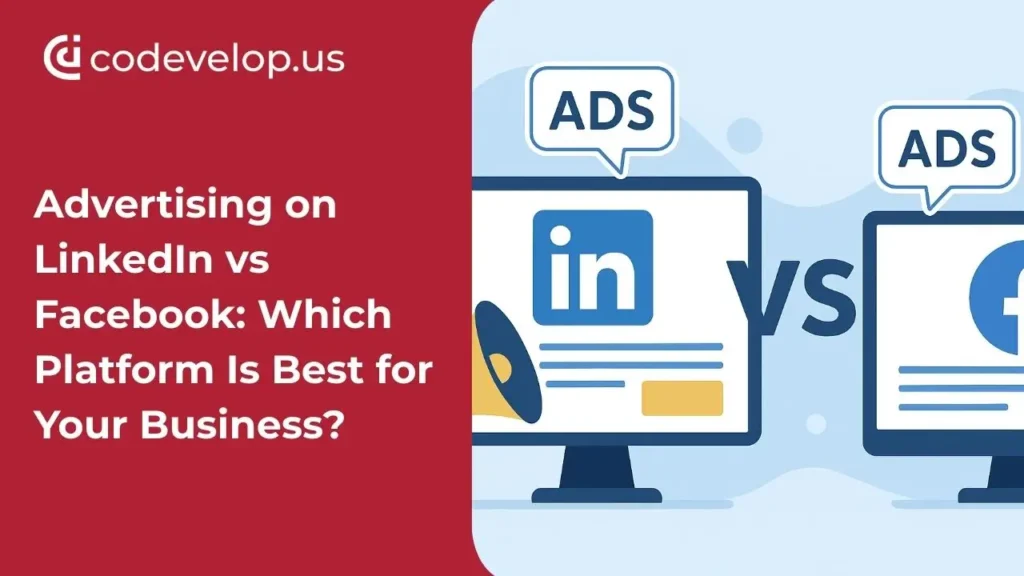Why This Debate Matters
Digital advertising is no longer about “being everywhere” — it’s about being where your audience is most likely to notice, trust, and act. For most businesses, LinkedIn and Facebook are the heavyweight contenders. Both offer massive reach, robust targeting, and measurable ROI, but they serve very different purposes.
At Codevelop, we help businesses fine-tune their digital marketing strategies so every ad dollar is spent with intention. In this deep dive, we’ll explore the strengths, weaknesses, and strategic differences between LinkedIn advertising and Facebook advertising, and help you decide which (or both) fit your marketing plan.
Understanding the Platforms
LinkedIn: The Professional Network
LinkedIn is designed for professional networking, thought leadership, and B2B relationship building. With over 1 billion members, it’s the go-to place for reaching decision-makers, industry professionals, and high-intent B2B audiences.
Common ad formats include:
- Sponsored Content (in-feed ads)
- Sponsored InMail / Message Ads
- Dynamic Ads (personalized for the viewer)
- Text Ads
Because it’s professional-first, users often have a business mindset when engaging with LinkedIn content.
Facebook: The Social Giant
With nearly 3 billion monthly active users, Facebook offers unmatched scale and versatility. While it’s more consumer-focused, it’s also a valuable B2B tool — especially when targeting by interests, behaviors, and demographics.
Ad formats include:
- Image and Video Ads
- Carousel Ads
- Instant Experience
- Collection Ads
Facebook users may be in a more casual mindset, but the targeting power and creative possibilities are hard to beat.
Audience Targeting Capabilities
LinkedIn Targeting Strengths
LinkedIn shines when you need professional filters:
- Job title, seniority, and function
- Company size and industry
- Skills and certifications
- Professional groups and interests
If you’re selling B2B services — like performance marketing for enterprise clients — LinkedIn lets you laser-focus on decision-makers without wasting impressions.
Facebook Targeting Strengths
Facebook allows broader lifestyle and behavioral targeting:
- Age, gender, and location
- Interests, hobbies, and life events
- Purchase behavior and device usage
- Custom and lookalike audiences
This makes it a powerhouse for B2C brands and local businesses — especially when paired with Local SEO and retargeting campaigns.
Ad Costs and ROI Potential
LinkedIn Advertising Costs
LinkedIn generally comes with higher CPCs (cost-per-click) — often in the $5–$12 range, depending on audience specificity and competition. However, if each lead is highly valuable (think high-ticket services, enterprise contracts, or specialized consulting), the ROI can justify the cost.
Facebook Advertising Costs
Facebook’s CPC can be dramatically lower — sometimes under $1 — making it easier to reach large audiences on smaller budgets. The trade-off? Lead quality can vary more, and you may need more volume to hit your revenue targets.
Creative Approach and Engagement
LinkedIn Creative Best Practices
- Use professional, insight-driven messaging
- Highlight industry expertise and ROI-focused outcomes.
- Leverage case studies and whitepapers as lead magnets
- Keep visuals polished and on-brand
For example, if you’re promoting a web development service for enterprise clients, an ad showcasing measurable results for past B2B projects can outperform a generic sales pitch.
Facebook Creative Best Practices
- Use vibrant imagery and eye-catching video.
- Create emotional or aspirational hooks.
- Highlight promotions or limited-time offers.
- Encourage interaction with polls, comments, or quizzes.
If you’re promoting a PPC campaign for a local brand, lifestyle-driven ads with bold visuals often pull better engagement.
Lead Quality vs. Lead Volume
- LinkedIn typically delivers fewer leads but with higher intent and stronger alignment to your ideal customer profile.
- Facebook often produces more leads at a lower cost — but you may need to nurture them longer before they convert.
The best choice depends on your sales cycle, offer price point, and how quickly you need ROI.
Analytics and Tracking
Both platforms offer strong reporting dashboards, but Facebook’s pixel tracking and integration with Meta Ads Manager make it particularly powerful for remarketing campaigns. LinkedIn provides detailed demographic insights, which are invaluable for refining B2B targeting.
Pairing these insights with SEO data can create a full-funnel picture of where your prospects are engaging.
Industry Use Cases
- Best for B2B: LinkedIn Ads promoting enterprise software, consulting, professional services, or high-ticket training programs.
- Best for B2C: Facebook Ads for e-commerce products, local services, events, or lifestyle brands.
- Best for Hybrid Models: Businesses with both B2B and B2C audiences (e.g., SaaS with enterprise packages and small business tiers) can use both platforms strategically.
When to Choose LinkedIn Over Facebook
- Your audience is primarily decision-makers in specific industries.
- You offer high-value B2B products or services.
- You’re focused on lead quality over sheer volume.
- You can invest in higher CPCs for better-qualified leads.
When to Choose Facebook Over LinkedIn
- You want to reach a broader audience affordably.
- You’re promoting B2C products or local services.
- Your brand benefits from emotional, lifestyle-driven storytelling
- You’re testing offers and want fast, low-cost feedback.
Why You Might Use Both
Many of our clients at Codevelop see strong results by running both — for example:
- Use LinkedIn Ads for high-intent lead generation among decision-makers
- Use Facebook Ads for retargeting, brand awareness, and nurturing leads at a lower cost.
This dual-platform strategy ensures you’re present in both professional and personal browsing moments, creating multiple touchpoints that reinforce your brand.
Best Practices for Either Platform
- Test continuously — run A/B tests on headlines, visuals, and targeting.
- Track everything — use UTMs and analytics tools for accurate attribution.
- Integrate channels — combine ads with content marketing, SEO, and email for maximum impact.
- Focus on landing page quality — even the best ad fails if the click leads to a weak page.
- Nurture leads — build follow-up sequences to convert interest into revenue.
Final Verdict
There’s no universal winner in the LinkedIn vs Facebook advertising debate. The “best” choice depends on your audience, goals, and resources.
- If you’re B2B and chasing high-intent decision-makers, LinkedIn Ads are worth the premium.
- If you need reach, versatility, and lower costs, Facebook Ads can deliver faster scale.
- For many brands, a combined approach provides the best of both worlds.
At Codevelop, we specialize in building multi-channel ad strategies that balance lead quality with lead volume, while maximizing ROI. Whether you’re aiming to dominate LinkedIn, Facebook, or both, our team can design campaigns that get noticed and get results.


